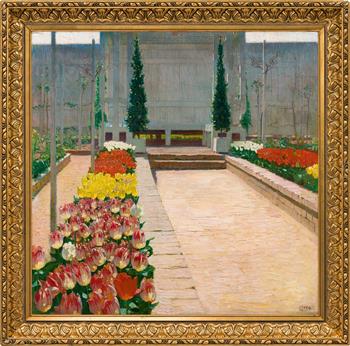0013
Carl Moll
(Wien 1861 - 1945 Wien)
„Garten im Frühling auf der Hohen Warte“
1903
oil on canvas; framed
100 x 100 cm
signed on the lower right: C. Moll
remains of an old artist's label with handwritten no. 168 and an inscription by the hand of the artist on the reverse on the stretcher: Gart(en im) Frühling and numbered label no. 168 (probably label of the exhibition Wiener Werkstätte 1906, Museum Folkwang, Hagen)
Provenance
after 1906 family of Anna Moll (née Bergen), Hamburg;
by inheritance to Helene Raskop, Hamburg;
by inheritance to Gertrud Helene Raskop (deceased on 23.11.1978), Hamburg;
by inheritance to the aunt of the present owner, private property Hamburg;
since 1997 German private property
Exhibition
1906 Hagen, Museum Folkwang, exhibition "Wiener Künstler" (Wiener Werkstätte), November/December, no. 168 (exhibition label verso)
The painting is documented in the supplement to the Carl Moll catalogue raisonné in the Belvedere catalogue raisonné series under the number GE 189B.
We are grateful to Dr. Cornelia Cabuk for her kind assistance with the cataloguing.
Estimate: € 250.000 - 500.000
Hammer price: € 380.000
Auction is closed.
“(...) he (Moll) is one of the most conscious proponents of modern living culture and each of his brushstrokes directly reflects his conviction and way of life. He lives in a villa built by Hoffmann on the Hohe Warte, a colony of villas that owes its entire layout to Hoffmann. Between beautiful white houses lie spacious gardens with neat terraces and arcades, carefully tended and fitted out with white furniture. It is from this environment that Moll’s motifs originate.” (Review of the “Ausstellung Wiener Künstler im Folkwang” [“Exhibition of Viennese Artists at the Folkwang”], in: Haener Zeitung, no. 282, 1.12.1906, p. 2)
The painting “Garten im Frühling auf der Hohen Warte” (“Garden in Spring on the Hohe Warte”) is a rare masterpiece of Viennese modernism, previously unknown in the art world. Painted in 1903 and exhibited at the Folkwang Museum in Hagen in December 1906, the painting probably made its way to Hamburg a little later, where the family of Anna Schindler-Moll (née Bergen) lived. Since then, Moll’s wonderful view of the garden of the Villa Moll/Moser in Döbling, freed from narrative details, has remained hidden from the public eye in German private property for more than one hundred years. We consider ourselves fortunate that this newly discovered jewel from the heyday of Secessionist art has found its way back to Vienna and that we are able to present the painting for the first time in over a hundred years.
(Claudia Mörth-Gasser)
Moll painted the picture “Garten im Frühling” (“Garden in Spring”) from the porch of the Moll-Moser duplex on Hohe Warte facing south. A narrow, paved path, bordered by low brick walls and tulip beds, leads to an arbour symmetrically flanked by small box trees in cuboid pots. The idea of the Gesamtkunstwerk or total synthesis of the arts in Josef Hoffmann’s architecture also extended to the joint planning of the “Reform Gardens”, in which architecture and nature formed a stylistic unity ordered according to geometric relationships. At the artists’ colony on the Hohe Warte, the unity of life and art was realised in an ideal way in a culture of modern taste. The clearly structured, harmoniously designed, modern environment was intended to enable people to live in a devoted harmony with nature. The idea of a reform of life is clearly documented in Moll's cycle of paintings of the Hohe Warte in his impressionistic depiction of the equally stylised interior and exterior spaces At the 17th Secession exhibition in 1903, Moll presented a collection of his paintings of the Hohe Warte, including garden pictures, which was acclaimed by the art critic Ludwig Hevesi. After leaving the Secession together with the Klimt Group, Moll, as director of the Miethke Gallery, promoted the Wiener Werkstätte (“Viennese workshops”), founded in 1903 by Fritz Waerndorfer, Koloman Moser and Josef Hoffmann, by presenting them at the newly designed venue on the Wiener Graben in December 1905, and by arranging for Karl Ernst Osthaus to show their work at the Folkwang Museum in Hagen, Germany, in December 1906 under the title „Ausstellung Wiener Künstler“ (“Exhibition of Viennese Artists”). There, Moll’s paintings were shown, together with the arts and crafts of the Wiener Werkstätte. To illustrate “the new Viennese life”, Moll included the “Weiße Interieur” (“White Interior”) (GE 223) as well as paintings of the Hohe Warte, among them probably „Garten im Frühling" (”Garden in Spring).
(Cornelia Cabuk)



